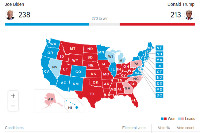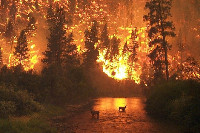WunderQuiz
U.S. Presidential Elections. How does it work?

U.S. Presidential Elections. How does it work?
Test your knowledge of the American Presidential Elections!
Quiz Preview
To run for President of the United States of America, you must :
That's why actor Arnold Schwarzenegger, former governor of California, couldn't run for president because he was born in Austria.
The U.S. President is elected for a term of ... ?
In the United States it's 4 years, in France it's 5: a quinquennium.
By definition, a quinquennium is a period of five years.
How old must be the U.S. President ?
The US president is limited to serving how many terms ?
Under the 22nd Amendment to the U.S. Constitution, a president is limited to serving two elected four-year terms.
This provision was introduced in 1951, following Franklin Delano Roosevelt's four terms in office.
Primary elections are held to designate in each state . . .
In the United States, these state-level elections are generally referred to as the “presidential primaries” (often paired with caucuses in states that use those instead). During these primaries (and caucuses), voters select delegates who will then formally nominate each party’s presidential candidate at the national party conventions.
To win the presidential election, the candidate must . . .
The total number of votes in the Electoral College is :
In order to win a U.S. presidential election, a candidate must earn a majority of the votes in the Electoral College—currently, 270 out of the total 538 electoral votes.
To be elected, the candidate must obtain a majority of :
Each state has a defined number of electoral votes. The number depends:
Each state has a different number of electoral votes:
In 2020: e.g. 29 for Florida, Alaska 4, 55 in California
The U.S. presidential election is based on ______ suffrage.
- restricted, if it is limited to a category of population according to its income (censal suffrage) or its level of knowledge (capacitive suffrage);
- universal, if all adult citizens vote;
- direct, if the elector himself votes for a candidate;
- indirect, if the candidate is elected by an electoral college, itself designated directly by the citizens.
What happens if two candidates tie?
In the context of a U.S. presidential election, if two candidates end up tied in the Electoral College vote—or if no candidate achieves the required majority of 270 electoral votes—the Constitution provides a clear procedure:
1) The House of Representatives Chooses the President
2) The Senate Chooses the Vice President
This process is outlined primarily in the 12th Amendment to the U.S. Constitution.
The President will take office ____ at noon on Inauguration Day.
The President has a Vice President. What is his role?
The Vice President of the United States is the second-highest executive official, serving directly under the President. They act as President of the Senate and can cast a tie-breaking vote when necessary. Additionally, the Vice President assumes the presidency if the President becomes unable to serve.
In all states except ____ and ____, the winner of the election wins his or her electors.
Maine and Nebraska distribute their electoral votes in proportion to the statewide vote.
The other states are winner-take-all, meaning that the party of the candidate who comes out on top in a state wins all the electors in that state.
On January 20 following the election, the new President is sworn in on ____ .
There is no constitutional requirement in the United States that a president use the Bible when taking the oath. While it is traditional for most presidents to be sworn in on a Bible, each incoming president is free to choose any sacred text—or no text at all—for their oath of office.
For instance, a Hindu or Muslim president could opt to use a copy of their own sacred scripture if they wished.
John Quincy Adams (1825) placed his hand on a law book, Theodore Roosevelt (1901) did not use a Bible and Lyndon B. Johnson (1963) was sworn in aboard Air Force One using a Roman Catholic missal that was on hand, rather than a Bible.
Since when have black men (not women) been allowed to vote?
In theory, black men have been able to vote since 1870, but in practice, in the south of the country, many blacks were excluded from the right to vote until 1965.
Since when have black women the right to vote?
Legally, Black women in the United States gained the right to vote in 1920 with the ratification of the 19th Amendment, which prohibited denying the right to vote on the basis of sex.
However, in practice—especially in many Southern states—racist laws and intimidation tactics barred most Black women (and men) from actually voting until the passage of the Voting Rights Act of 1965, which provided federal enforcement to protect their suffrage rights.


